Enhanced crash investigations required to identify the underlying causes of heavy vehicle crashes
Ivan Cikara1*, Geoff Dell2, Yvonne Toft3, Shevaun Dell4, Aldo Raineri5
1*Central Queensland University, 554-700 Yaamba Rd, Norman Gardens, Rockhampton, Queensland 4701, ivan.cikara@cqumail.com
2Professor at the University of Ostrava, VŠB-Technical University of Ostrava, Faculty of Safety Engineering, Lumírova 13, Ostrava-Výškovice, 700 30 and Adjunct Associate Professor at Central Queensland University 554-700 Yaamba Rd, Norman Gardens, Rockhampton, Queensland 4701
3Professor at the University of Ostrava, VŠB-Technical University of Ostrava, Faculty of Safety Engineering, Lumírova 13, Ostrava-Výškovice, 700 30
4Formerly Central Queensland University, 200 Spencer Street, Melbourne, Victoria 3000
5Central Queensland University, 160 Ann St, Brisbane, Queensland 4005
Abstract
The heavy vehicle transport industry has been described as Australia’s deadliest and truck drivers are 16 times more likely to die at work than workers in any other industry. The number of driver fatalities in the heavy vehicle transport industry is almost four times the total number of fatalities in the aviation, rail and maritime industries combined. While the financial cost to society as a result of these fatal crashes in the heavy vehicle transport industry is significant; annually over $A1billion, they are overshadowed by the social impacts which are immense with the bulk of the burden falling on the victims, their families, friends and communities. Effective crash investigation in other industries, especially aviation, has resulted in substantial and sustained reduction in the rates of serious accidents suggesting that if heavy vehicle crash investigations in Australia were effective, underlying causes of these crashes would be identified and a significant reduction in the number of crashes should be evident.
However, this does not appear to be the case and heavy vehicle drivers continue to be blamed for crashes. There appears to be an apparent lack of understanding of why and how these crashes occur and what is needed to prevent them.
This paper reports on a survey of 320 heavy vehicle transport industry personnel whose opinions were sought on a range of key issues impacting safety in the industry.
The overwhelming majority of respondents supported the notion that heavy vehicle drivers were blamed for crashes; the investigations were shallow and ineffective resulting in the causes not being understood and the prevention lessons not being learned. In addition to the most prevalent comment made by respondents that drivers were blamed, the greater majority of respondents suggested Regulators must do more to investigate and properly analyse the cause of a heavy vehicle fatal crash and the industry needs to have an independent national heavy vehicle crash investigation agency to investigate heavy vehicle crashes.
This paper concludes that heavy vehicle crash investigations need to look beyond blaming the driver. To achieve this an independent national heavy vehicle crash investigation agency is needed to properly analyse the underlying causes of a heavy vehicle fatal crash. The agency needs to have investigators that have the experiences, skills, competencies and the investigative methodologies to properly conduct heavy vehicle fatal crash investigations so that the root causes are identified and the blame is not focused on the heavy vehicle driver.
Keywords: Heavy Vehicle, Blame, Investigations, Crashes, Transport, Driver
1. Background
The heavy vehicle transport industry has been described as Australia’s deadliest occupation with truck drivers being 16 times more likely to die at work from heavy vehicle crashes than workers in any other industry (Transport Workers Union 2012; Sydney Morning Herald 2015; Patty 2015; News 2018). There are more deaths in the heavy vehicle transport industry than there are in all other transport and workplace industries combined (Cikara et al. 2020b). In the 12 months ending June 2020, 157 people died in Australia from crashes involving heavy vehicles (BITRE 2020). This is almost four times greater than the combined total number of deaths that has occurred in the same period within the aviation, rail and maritime industries, which have an aggregated total of 42 deaths (BITRE 2020; ONRSR 2019; AMSA 2019). It should be noted that fatal crashes represent only a small proportion of the total number of heavy vehicle crashes that occur in Australia annually.
As a result, heavy vehicle crashes are a significant personal burden on victims, their families and others affected in the community as well as being a significant cost to the transport industry and Australian society. In a submission to the Australian Government, Litchfield (2017) reported that the average cost of a fatality in Australia was approximately AU$7.8 million. This suggests the cost of fatalities in the heavy vehicle transport industry alone amounted to around AU$1.224 billion in that year to June 2017. The statistics highlight that there is an unacceptably high number of crashes in the heavy vehicle transport industry yet there appears to be no progress being made to identify and address what are the systemic underlying causes for these crashes and more needs to be done to identify why. There is a clear need for government and the heavy vehicle transport industry to take action to address this major problem.
Some authors have suggested that understanding crash causation is intrinsic to their successful prevention and that little can be done if the causes of accidents are not known. They argue that effective investigation is the vehicle for establishing the actual causes of accidents so that effective corrective actions can be taken (Lederer 1988; Kletz 2001; Matthews 2014; Braithwaite 2015). For example, Lederer (1995) asserts that investigation of aircraft crashes has been responsible for driving a significant and sustained reduction in the frequency of air crashes over the past 60 years. If current arrangements for heavy vehicle crash investigation in Australia were effective, then there should have been a significant reduction in heavy vehicle crashes. However, this seems not to be the case as heavy vehicle crashes continue to happen at the same rate. There is clearly a lack of understanding of why and how these crashes occur and what is needed to prevent them from reoccurring (Toft et al. 2012; Dell 2015). Brodie et al. (2010) and Cikara et al. (2020a) take the argument further and suggest that many investigations into heavy vehicle crashes are not properly conducted.
The laws that govern the heavy vehicle transport industry in Australia, the Heavy Vehicle National Law (HVNL) enacted in all states of Australia except Western Australia (WA) and the Northern Territory (NT)[1], and the Compliance and Enforcement (C&E) legislation enacted in Western Australia, were introduced to address the long-recognised driver-centric investigative approach of apportioning blame for heavy vehicle road safety breaches (Anderson & Bailey 2005; Farnsworth & McCarthy 2016). These laws are colloquially known as the ‘Chain of Responsibility’ (CoR) legislation. These laws recognise that it is not just the driver who is responsible for breaches and crashes, but also other parties who exercise control or influence over the transport task. However, a ‘blame the driver’ culture in government and in the heavy vehicle industry still exists according to many observers (Quinlan 2001; Wright & Quinlan 2008; Dell 2015; Newnam & Goode 2015; Mooren et al. 2015; Mooren 2016; Newnam et al. 2017; Cikara et al. 2020a; Cikara et al. 2020b).
Heavy vehicle crash investigations must look beyond blaming the driver, and instead analyse all the factors in the socio-technical system that influenced the events and contributed to causation. Investigations must explore factors that adversely affect heavy vehicle driver decisions and actions and why they make those decisions and take those actions. Factors such as financial pressures, payment conditions, economic pressures, poor maintenance (Hensher et al. 1991; Quinlan et al. 2006; Wright & Quinlan 2008; Stevenson et al. 2010; Walker 2012; Thompson et al. 2014; Thompson & Stevenson 2014; Mooren et al. 2014; Mooren et al. 2015). Investigations must dig deeply to identify why heavy vehicle drivers are non-complaint, breach fatigue laws, speed, use stimulant drugs (Braver et al. 1992; Cheng 2006; Williamson 2007; Jones 2013; Thompson et al. 2015) and identify mitigation strategies to reduce the risk of a crash from occurring. It is argued that focusing on heavy vehicle driver behaviour alone does not identify the root causes of a crash and the opportunity to capture other contributory factors is missed (Brodie et al. 2009; Salmon et al. 2012; Newnam & Goode 2015; Salmon & Lenne 2015; Dell 2015; Cikara et al. 2020a).
This paper reports on a survey of heavy vehicle transport industry personnel that sought opinions on the issues of heavy vehicle crash investigation, blame the driver, heavy vehicle legislation, identifying the underlying causes of crashes, and a range of other issues affecting heavy vehicle transport safety.
2. Method
A survey of 20 statements was developed and published on Survey Monkey. A five-point Likert-Scale was used to capture the opinions and for each statement respondents were given the opportunity to comment in free text. Respondents were recruited via social media, the heavy vehicle industry and professional associations and contacts.
In this survey the respondents selected the response which most closely aligned with their attitude to each statement using the Likert Scale: Strongly Disagree =1, Disagree =2, Undecided =3, Agree =4 and Strongly Agree =5. Mean scores were calculated for each statement for each respondent group.
Table 3 shows the mean scores calculated for each statement for each respondent group. Table 3 also shows the mean scores calculated across all six groups for each statement as well as the number of free text comments made by respondents against each statement.
2.1 Discussion of results
There were 320 responses to the survey. Respondents included heavy vehicle company Chief Executives Officers, drivers, loaders, packers, managers, owner operators, government employees, industry association representatives and other individuals from organisations within the heavy vehicle transport industry.
2.1.1 Demographics
The survey sought the opinion and perceptions of a varied cohort of heavy vehicle industry workers. The respondents were asked to select which position they held within the industry according to a list provided in the survey. The following is a breakdown of the number of respondents according to that list.
2.1.2 Roles of respondents
Respondents self-identified their roles within the industry into 20 specific roles. Those self-identified roles are disclosed in Table 1.
| Nr | Job Role | N= | % |
|---|---|---|---|
| 1 | Loader | 0 | 0.00 |
| 2 | Packer | 1 | 0.31 |
| 3 | Driver | 173 | 54.06 |
| 4 | Scheduler | 3 | 0.94 |
| 5 | Consignor | 0 | 0.00 |
| 6 | Consignee | 0 | 0.00 |
| 7 | Manager | 21 | 6.56 |
| 8 | Supervisor | 10 | 3.13 |
| 9 | General Manager | 12 | 3.75 |
| 10 | Chief Executive Officer | 6 | 1.88 |
| 11 | Legislator | 1 | 0.31 |
| 12 | Union Representative | 0 | 0.00 |
| 13 | Industry Representative | 6 | 1.88 |
| 14 | Trainer Educator | 9 | 2.81 |
| 15 | Owner Operator | 41 | 12.81 |
| 16 | Sub-Contractor | 4 | 1.25 |
| 17 | Client | 1 | 0.31 |
| 18 | Unloader | 0 | 0.00 |
| 19 | Prime Contractor | 2 | 0.63 |
| 20 | Other | 30 | 9.38 |
| Total | 320 |
Table 1: Roles of respondents
The roles outlined in Table 1 were further distilled into six specific categories that best aligned to the respondent’s responsibilities and duties to deliver safety and compliance within the heavy vehicle transport industry (See Table 2). The Driver group included any respondent whose primary role involved a driving activity as part of their duties. Those respondents in the Management group must have had management responsibilities. Safety Personnel were those respondents whose responsibilities include safety-related activities and responsibilities. Industry Representatives were those respondents who were more on the periphery, such as users of the heavy vehicle transport industry and who could be considered third parties to the heavy vehicle transport industry. Regulators were those respondents who are in a government agency and have oversight of the heavy vehicle transport industry and Chain of Responsibility (CoR) Parties were those respondents who work in the heavy vehicle transport industry but who are not drivers, instead undertaking other responsibilities that assist the driver.
| Driver | Management | Safety Personnel | Industry Representatives | Regulatory | CoR Parties |
|---|---|---|---|---|---|
| Company Driver & Owner Operator | Chief Executive Officer | Compliance | Industry Representative | Legislator | Freight Area Coordinator |
| Contract Driver and Mechanic | Director of my Company | Compliance Officer | Insurance Broker | Packer | |
| Driver | General Manager | Compliance and Safety Manager | Client | Scheduler | |
| Driver and Industry Rep | Manager | Consultancy | Supervisor | ||
| Driver Loader Unloading Everything | Consultants | ||||
| Linehaul | HSE Manager | ||||
| Mechanic / Driver | Load Restraint Engineer | ||||
| Owner/Operator | Mechanic | ||||
| Prime Contractor | Motor Vehicle Safety Consultant | ||||
| Retired | National WHS, Compliance & Training Manager | ||||
| Small Transport Business Owner | OHS | ||||
| Sub-contractor | Safety | ||||
| All of the above | Safety Consultant | ||||
| Safety Manager | |||||
| Telematics | |||||
| Trainer/Educator | |||||
| Vehicle Modifications |
Table 2: The respondents placed into specific categories
2.2 Roles of respondents
The roles of the respondents is broken down into the six groups as depited in Figure 1.
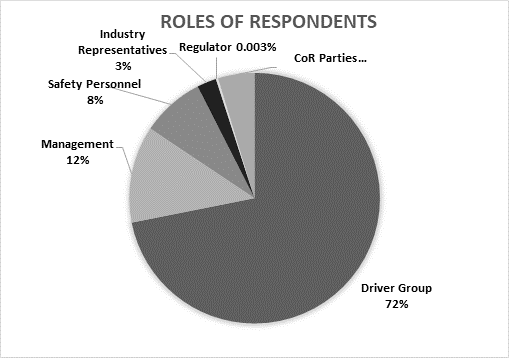
Figure 1: Roles of respondents
2.3 Age brackets
The age bracket of the respondents is broken down into subsections as shown in Figure 2.
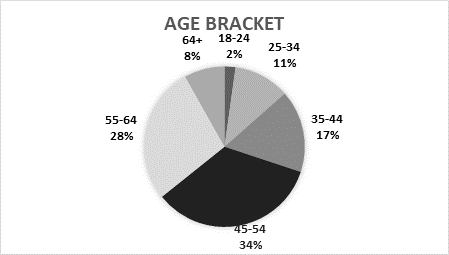
Figure 2: Age brackets
2.4 Years of experience
The years of experience from the respondent is broken down into subsections as shown in Figure 3.
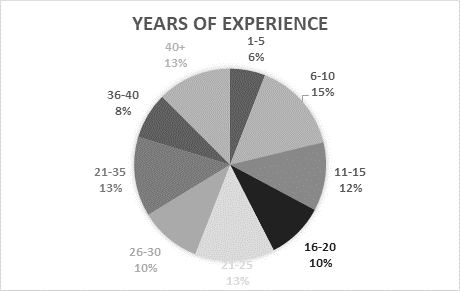
Figure 3: Years of experience
2.5 State of employment
The respondents’ state of employment is identified in Figure 4.
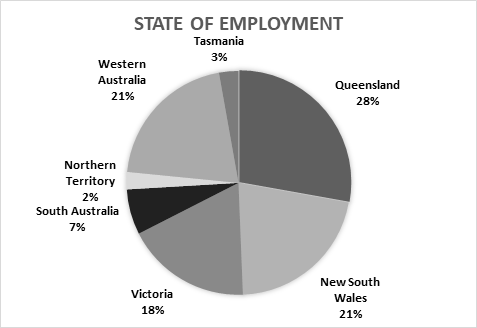
Figure 4: State of employment
2.6 Coding of the survey
The intensity of attitude for each group was scored in the 20 survey questions to obtain a mean score for each statement as shown in Table 3.
| Statements | Groups | Total Respondents | Mean Score | Number of Free Text Comments | ||||||
|---|---|---|---|---|---|---|---|---|---|---|
| CoR Parties | Regulator | Industry Reps | Safety Personnel | Management | Drivers | |||||
| (n=15) | (n=1) | (n=8) | (n=26) | (n=40) | (n=230) | (n=320) | ||||
| 1 | The 'Chain of Responsibility' legislation has improved safety in the road transport industry in Australia. | 3.20 | 4.00 | 2.25 | 2.96 | 3.25 | 3.00 | 320 | 3.11 | 109 |
| 2 | The 'Chain of Responsibility' legislation is easy to understand. | 2.73 | 4.00 | 2.37 | 2.69 | 2.92 | 2.63 | 320 | 2.89 | 42 |
| 3 | The 'Chain of Responsibility' legislation should be harmonised nationally. | 4.13 | 3.00 | 3.88 | 4.26 | 4.08 | 4.13 | 319 | 3.91 | 34 |
| 4 | The 'Chain of Responsibility' legislation is effective in reducing crashes in the transport industry. | 2.53 | 3.00 | 2.00 | 2.57 | 2.68 | 2.12 | 318 | 2.48 | 69 |
| 5 | The 'Chain of Responsibility' legislation controls the risk of crashes occurring. | 2.47 | 4.00 | 2.25 | 2.42 | 2.37 | 2.10 | 318 | 2.60 | 49 |
| 6 | The 'Chain of Responsibility' legislation is effective in managing road safety risk. | 3.06 | 4.00 | 2.13 | 3.46 | 2.68 | 2.34 | 319 | 2.95 | 48 |
| 7 | The 'Chain of Responsibility' legislation has made a positive impact on the management of road transport safety. | 2.87 | 4.00 | 3.63 | 2.96 | 3.05 | 2.43 | 320 | 3.15 | 41 |
| 8 | The 'Chain of Responsibility' legislation is important to you and your own safety on the road. | 3.33 | 4.00 | 4.13 | 3.96 | 3.53 | 3.38 | 320 | 3.72 | 43 |
| 9 | The 'Chain of Responsibility' legislation helps keep all drivers in the road transport industry safe. | 2.73 | 4.00 | 4.13 | 2.81 | 2.73 | 2.37 | 319 | 3.13 | 53 |
| 10 | The road transport industry complies with the 'Chain of Responsibility' legislation. | 3.00 | 3.00 | 2.13 | 3.34 | 3.55 | 2.41 | 318 | 2.91 | 56 |
| 11 | The 'Chain of Responsibility' is integral to everything I do in the road transport industry. | 3.40 | 4.00 | 3.38 | 3.34 | 3.55 | 1.69 | 320 | 3.23 | 31 |
| 12 | If there is an opportunity to avoid compliance with the 'Chain of Responsibility' legislation, I would take that opportunity. | 1.60 | 2.00 | 2.38 | 2.19 | 1.60 | 2.26 | 320 | 2.01 | 40 |
| 13 | Complying with the 'Chain of Responsibility' legislation will affect my business and my livelihood. | 2.60 | 3.00 | 2.63 | 2.61 | 3.25 | 3.00 | 320 | 2.84 | 36 |
| 14 | I am not concerned with the consequences of breaching the 'Chain of Responsibility' legislation. | 1.87 | 2.00 | 1.88 | 2.07 | 1.95 | 2.20 | 319 | 2.00 | 27 |
| 15 | Surviving financially is more important than complying with the 'Chain of Responsibility' legislation. | 2.00 | 2.00 | 2.13 | 2.61 | 2.20 | 2.76 | 318 | 2.28 | 44 |
| 16 | Investigations into heavy vehicle crashes identify the root causes. | 2.80 | 3.00 | 1.88 | 2.65 | 2.57 | 2.22 | 318 | 2.52 | 60 |
| 17 | Heavy vehicle drivers are blamed for heavy vehicle crashes. | 4.13 | 4.00 | 4.75 | 4.26 | 4.40 | 4.60 | 319 | 4.35 | 57 |
| 18 | Investigations into heavy vehicle fatal crashes are not properly conducted. | 3.53 | 2.00 | 4.38 | 3.92 | 3.43 | 3.91 | 319 | 3.52 | 45 |
| 19 | Regulators must do more to investigate and properly analyse the cause of a heavy vehicle fatal crash. | 4.07 | 4.00 | 4.88 | 4.50 | 3.50 | 4.30 | 320 | 4.31 | 32 |
| 20 | The industry needs to have an independent national heavy vehicle crash investigation agency to investigate heavy vehicle crashes. | 3.33 | 4.00 | 5.00 | 3.69 | 3.65 | 4.35 | 318 | 4.00 | 51 |
Table 3: Mean scores for each statement and each respondent group
3. Themes
Each of the 20 statements in this survey was allocated to one of five separate themes that best described that statement: Legislation, Influence, Compliance, Consequence and Investigations. The allocation of statements to the themes are identified in Figures 5, 6, 7, 8 and 9.
Any statement that specifically referred to the legislation was placed into the Legislation theme. There were six statements that fell into this theme - statements 1-6. Any statement that inferred any Influence or impacts were placed into the Influence theme. There were four statements that were included in this theme - statements 7, 8, 9 and 11. Any statement that expressed key words that refer to compliance were included in the Compliance theme. There were three statements that met this criterion - statements 10, 12 and 13. The Consequence theme only included two statements - statements 14 and 15. This theme referred to the outcomes or behaviours of the respondents based on their compliance with the legislation. The final theme was Investigations. This included statements that referred to investigations, their outcomes and what needed to be done with investigations. This theme captured five statements - statements 16-20.
All statements were placed into themes that best described that statement. A total of five themes were identified.
4. Findings
Respondent attitudes towards the statements that were grouped into each theme are shown in Figures 6 through 9 below. In each figure the intensity of agreement of respondents in each group for each statement is shown. The mean score for each group for each statement is also shown.
4.1 Legislation
There were six statements within the survey that were captured in the Legislation theme, as shown in Figure 5.
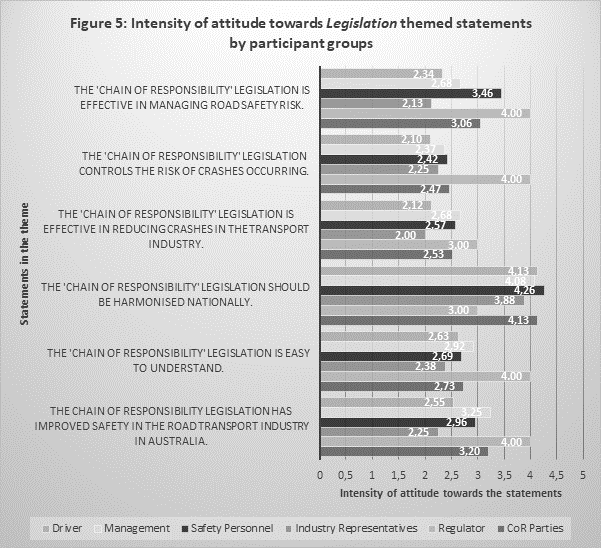
Figure 5: Intensity of attitude towards Legislation themed statements by participant groups
With regards to nationally harmonising the Chain of Responsibility legislation there was a strong intensity of attitude from Drivers (mean score of 4.13), Management (4.08), Safety Personnel (4.26), Industry Representatives (3.88) and CoR Parties (4.13). There was also consistency from Drivers (2.12), Management (2.68), Safety Personnel (2.57), Industry Representatives (2.00) and CoR Parties (2.53) that the legislation is presently not effective in reducing crashes in the heavy vehicle transport industry. Not surprisingly, Drivers (2.10), Management (2.37), Safety Personnel (2.42), Industry Representatives (2.25) and CoR Parties (2.47) do not agree that the Chain of Responsibility legislation controls the risk of crashes occurring.
These survey responses from the Drivers, Management, Safety Personnel, Industry Representatives and CoR Parties suggest there may be a lack of confidence in the usefulness of the Chain of Responsibility legislation to improving road transport safety, reducing the risks of crashes occurring and being effective in reducing crashes. This is further supported by the comments made by the respondents who stated they did not believe the legislation was having an impact. For example,
- ‘As yet I haven't seen anything change except paperwork’;
- ‘Idea is good, however has never been tested to its full potential. As such has had zero impact on road safety’; and
- ‘Has not changed anything, is barely enforced and all responsibility is still on the driver’.
These findings are consistent with an earlier study by Cikara et al. (2020a) which identified that the intent of the Chain of Responsibility legislation is to ensure that drivers alone are not blamed for safety breaches but hold accountable other parties for a driver’s actions. Jones (2013) identified that the lack of ability to comply with the law relates to the quality and sufficiency of the law itself. Jones went onto postulate ‘The law must provide a clear and unambiguous picture of what compliance looks like’ (pg. 3). It is not sufficient to create law and expect obedience (Cheng 2006; Jones 2013). Mooren et al. (2014) found the effects of legislation on safety in the heavy vehicle transport industry is not known. Studies suggest that the findings into the causation factors that adversely influence driver behaviour have not been translated into regulation or governmental policy (Quinlan et al. 2001; Belzer et al. 2002; Mooren et al. 2015).
There is a need for further research to identify how much impact, if any, the Chain of Responsibility legislation is having on the heavy vehicle transport industry. It is possible the cohorts who disagreed with the statements in this theme did so because they are at the frontline of the road safety experience and this might have led them to their conclusions about the efficacy and impacts of the legislation.
There is also a clear need for the opinion of more Regulators to be captured as the Regulators response in this study stood out amongst the others in the group providing a mean score of 4.00 for four of the six statements. However, there was only one respondent in the Regulator cohort which may not be a true representation of Regulators’ opinion and does not provide strong statistical confidence in this study.
4.2 Influence
There were four statements from the survey included in the Influence theme, as shown in Figure 6.
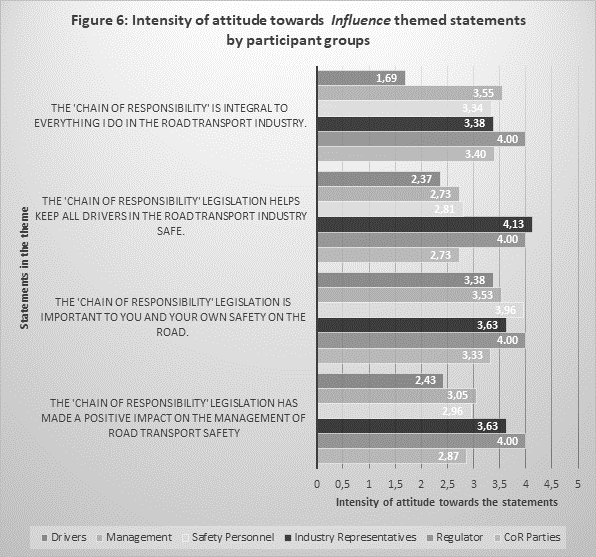
Figure 6: Intensity of attitude towards Influence themed statements by participant groups
For this category mostly positive responses to the statements were captured from Industry Representatives, Regulator, Management and Safety Personnel, but Drivers were consistently less favourable in their views. The entire cohort seemed to agree that the legislation was important to their safety; Drivers (3.38), Management (3.53), Safety Personnel (3.96), Industry Representatives (3.63), Regulator (4.00) and CoR Parties (3.33). However, with the exception of agreeing that the legislation is important, the Drivers were indifferent with regards to the overall ‘influence’ of the legislation. For example, in the statement ‘The Chain of Responsibility is integral to everything I do in the road transport industry’ the Drivers responded with a mean score of 1.69 compared to Management who scored (3.55), Safety Personnel (3.44), Industry representatives (3.38), Regulator (4.00) and CoR Parties (3.40). This suggests the Drivers have a strong intensity of disagreement to that statement compared to the other cohort and may be because of Drivers seeing the industry from a different perspective to the rest of the cohort. This is supported by some comments such as:
- I believe it has had a negative affect (sic) as supply chain parties have been too worried about what other parties are doing that they have not focused on the safety of their own operations….’
- ‘No, the chain of responsibility is a convenient place for third parties to hide behind and impose demands, without themselves being accountable’ and
- ‘The fact that, in reality, I am able to do just about anything I please whether it be legal or not, is a little disturbing’.
This suggests that Drivers may be influenced to complete tasks by others whom Drivers perceive as turning a blind eye to the intent of the legislation.
Previous studies have also suggested there are factors that adversely influence driver behaviour, beyond the reach of the Chain of Responsibility legislation, forcing drivers to take risks due to pressures placed upon them by economic factors (Jones 2013; Mooren et al. 2014; Mooren 2015). A Study by Thompson et al. (2015) found increased economic pressures influenced the heavy vehicle driver decision making process and this notion was supported by comments made by some respondents who stated:
- ‘I think all it has done has to create more and more accidents as a lot of the experienced drivers are leaving the industry because of some of the ludicrous rules and regulations are driving them out of the industry’; and
- ‘cor (sic) is currently legislation that is rarely enacted on. If it were to be enacted on more often then (sic) it would make a positive impact’; and
- ‘Some people try to do the right thing but others still don’t get what safety is all about’.
4.3 Compliance
Figure 7 shows the intensity of attitudes towards ‘Compliance’ themed statements.
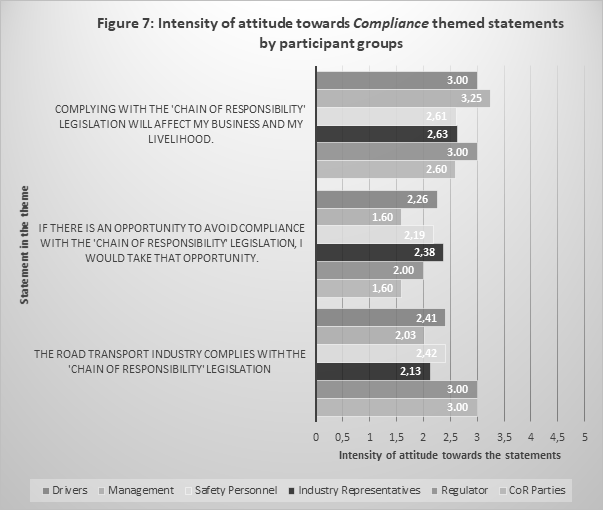
Figure 7: Intensity of attitude towards Compliance themed statements by participant groups
This Compliance theme produced a consistency of attitude from the entire cohort, who either agreed or were undecided with regard to the statements in this theme, with no respondents disagreeing. This was represented in the scores to the statement ‘if there is an opportunity to avoid compliance with the Chain of Responsibility legislation, I would take it’ with Management (mean score of 1.60) and CoR Parties (1.60). However, there were several comments that seem to contradict their responses to the statements in this theme. For example, some respondents stated:
- ‘Sometimes to get the job done because there is not a lot of profit in most of the transport industry so you need to get it done to survive. Politicians won’t sort out minimum pay rates after many inquiries they fail us and there answer just to fine us’;
- ‘Yes or you get sacked and left with no job so you dodgy up the log book’;
- ‘It's safety first till it costs money’;
- ‘Some people don’t have a choice but to not comply, when there’s drivers coming here from o/s and working for peanuts driving wages and rates down’;
- ‘Many still flaunt the rules in the name of profit’;
- ‘The unacceptable and often unpaid waiting times at many shipping and receivers still forces drivers into a position of feeling it may be necessary to break fatigue regulation in order to not lose wages, this by way of lost loads due to having to push timeslots/appointments out to meet chain of responsibility legislation’; and
- Many owner drivers struggle to make profits in the industry due to terrible freight rates and rates of pay’.
Yet their responses to the applicable statements were inconsistent with these sentiments. The comments imply there are other influencing factors in the heavy vehicle transport industry that may force some to be non-compliant, contradicting the intensity of attitude to this statement in the survey.
Jones (2013) identified that economics was a key reason why non-compliance to the heavy vehicle law occurred. Jones noted that the economic reality of the industry encouraged non-compliance, with temptations compounded by the structure of the industry. This is supported by Quinlan et al. (2006), Wright & Quinlan (2008), Stevenson et al. (2010) and Walker (2012) who cited economic pressures, compensation methods, freights rates, pay structures and increased demands on heavy vehicle drivers causing them to be non-compliant with the road rules and take risks that they otherwise would not take. In addition, Jones (2013) identified there were clear links between non-compliance, which was attributed to a lack of understanding of the complex laws and compliance responsibilities, and undesirable safety outcomes.
4.4 Consequence
There were two statements that were aligned to the ‘Consequence’ theme, as shown in Figure 8.
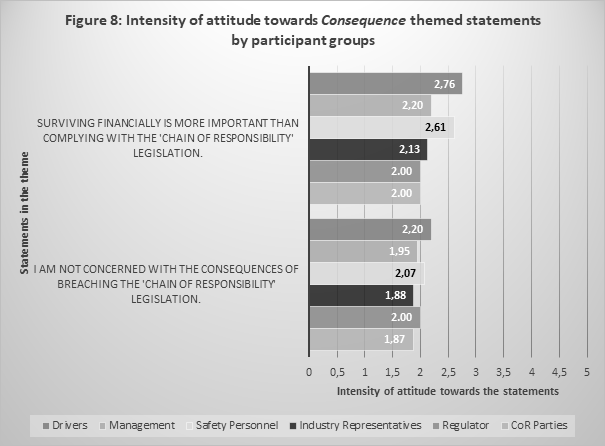
Figure 8: Intensity of attitude towards Consequence themed statements by participant groups
Responses to the statements in this theme showed a consistent intensity of attitude in disagreement with the two statements. For the first statement the intensity of attitude suggested that complying with the Chain of Responsibility comes before financial considerations. The mean scores were Drivers (2.76), Management (2.20), Safety Personnel (2.61), Industry Representatives (2.13), Regulator (2.00) and CoR Parties (2.00).
However, there were free text comments that also suggested a number of respondents disagreed with the intent of the statements. Several comments were opposed to the scores provided by the respondents to the statement suggesting there is a disconnect and a difference of attitudes. For example, as one respondent stated: ‘I’m not doing this job for love, money always overpowers safety. You want safety make the driver rates and conditions match safety’; and another stated: ‘Ask yourself that question and seriously think about it say no to your boss or the company that puts food on your table’.
For the second statement the groups responses resulted in the following scores: Management (mean score of 1.95), Industry Representatives (1.88) and CoR Parties (1.87) suggesting they are concerned about the ‘Chain of Responsibility’ legislation. This concern was supported by comments such as:
- ‘Absolutely petrified to consequences involved in breaching legislation, as it would affect my business’ and ‘I am very concerned but I need to earn a living and to keep up maintaining gear’ and
- ‘Yes I am because when something major happens it’s the driver fined and or imprisoned it’s his lively hood and mental health affected we are the scape goats’.
- However, there were some free text comments made by respondents that contradicted this sentiment. For example, some comments were:
- ‘daily have been told to break most laws for fatigue to overloading and drive unroadworthy trucks’;
- ‘I'll be answering to consequences whether I want to or not. If I don't defend myself, others may just find it easier to pass the blame and therefore load any consequences directly onto me’.
Other concerns raised by respondents included being pressured to complete work and concern that ‘fines are excessive’, and ‘being blamed for the actions of others’.
It is evident that there is conflict between the responses to the statements in this theme and the respondent’s free text comments suggesting some respondents may actually harbour opinions that financial considerations outweigh Chain of Responsibility compliance. Indeed, previous research by Quinlan (2001) suggested there is an increase in risk taking by drivers caused by the economic demands, intense competition of the industry and the financial impacts created by unrealistic freight rates, pay structures and client demands. Financial viability and surviving were key motivating factors for drivers who were prepared to be non-complaint and not concerned with the consequences of breaching legislation (Snyder 2012, Edwards et al. 2014).
4.5 Investigations
There are five statements in the Investigation theme as shown in Figure 9.
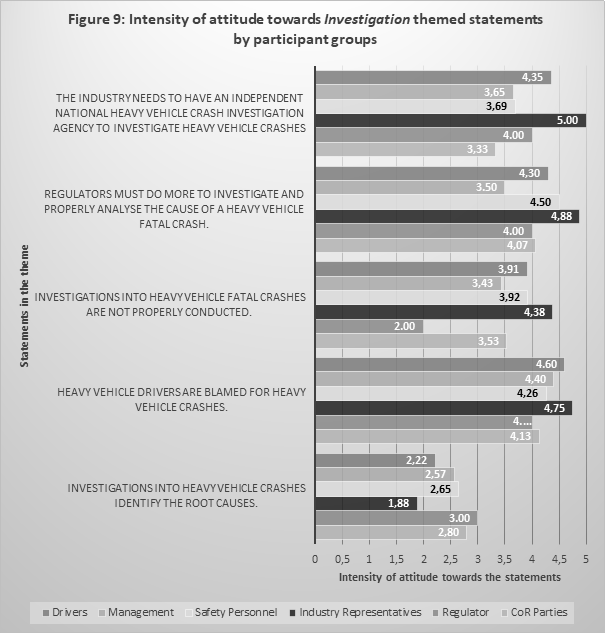
Figure 9: Intensity of attitude towards Investigation themed statements by participant groups
Survey responses to the theme ‘Investigations’ elicited strong intensity of attitude from Safety Personnel and Drivers to all statements within this theme. To highlight this point in response to the statement suggesting the ‘industry needs to have an independent national heavy vehicle crash investigation agency to investigate heavy vehicle crashes’, a mean score of 5.00 from Industry Representatives and 4.38 from Drivers resulted. CoR Parties (3.33), the Regulator (4.00), Safety Personnel (3.69) and Management (3.65) also supported the theme.
Strong intensity of attitude was also captured towards the statement that ‘heavy vehicle drivers are blamed for heavy vehicle crashes’. Drivers responded with a mean score of 4.60 with strong support from Industry Representatives (4.75). Management (4.40), Safety Personnel (4.26), Regulator (4.00) and CoR Parties (4.13) also all had a strong intensity of attitude towards this statement.
Similar intensity of response was evident in relation to the statement ‘Regulators must do more to investigate and properly analyse the cause of a heavy vehicle fatal crash’ with Drivers (4.30), Safety Personnel (4.50), Industry Representatives (4.88), Regulator (4.00) and CoR Parties (4.07) all strongly agreeing.
This pattern continued in the remaining statements which made this theme the most strongly supported across the entire survey. This would suggest consistent concern across the heavy vehicle transport industry that ‘Investigations’ must be improved for there to be better safety outcomes. The free text comments in this theme expressed the frustration and support the intensity of attitude:
- ‘All contributing factors are often over looked’; and ‘Too much focus on the driver not enough on the company's practices’;
- ‘ Drivers are blamed all too often, investigations don't dig deeply enough’;
- ‘Always.....and it is true, when the driver is at fault..... but Why? nobody is asking Why! ‘;
- ‘As always, those that are least able to defend themselves are the ones that end up being punished the hardest, that is, the truck driver's’;
- ‘They (drivers) are the first to get blamed even when 'its not their fault’; and
- ‘That has been said at so many meetings and conferences it is an accepted fact. Roadside enforcement officers often have a bias against truck drivers which they happily state’.
Despite contemporary research identifying many factors influencing driver behaviours and leading to heavy vehicle crashes (for example, Jones 2013; Mooren 2015), studies have identified that investigations have focused predominantly on blaming the driver, which has shifted the lens away from other underlying causes. Indeed, this is consistent with the findings of a number of authors (Quinlan 2001; Driscoll 2003; Newnam & Goode 2015; Newnam et al. 2017; Cikara et al. 2020a, Cikara et al. 2020b) who that argue heavy vehicle drivers are always invariably blamed for heavy vehicle crashes. This is clearly evident in the comments made by respondents such as:
- ‘Media and police always blame drivers until an investigation proves otherwise.... I speak from experience’; and
- ‘They (the drivers) are the first to get blamed even when its not their fault’.
Additionally, studies have identified several factors that have impacted on the quality of heavy vehicle crash investigations. Grabowski et al. (2009) and Salmon & Lenne (2009) found there was a need to improve the quality, type and detail of data captured and that the quality of investigations was influenced by the expertise and experience of those gathering the data, informed biases and preconceptions (Delaney et al. 2020). Previous studies into the causation factors of heavy vehicle fatal crashes concluded there is the need to develop a domain specific investigative methodology to identify the underlying causes contributing to heavy vehicle crashes (Brodie et al. 2009; Salmon et al. 2010; Salmon et al. 2012; Newnam & Goode 2015; Newnam et al. 2017; Cikara et al. 2020a; Cikara et al. 2020b).
Driscoll (2003) has identified that limited investigative resources and a lack of standard investigation approaches impedes the investigative process and information gathering. In other safety-critical domains, such as aviation, rail and maritime, safety has been improved through the application of a contextually structured and theoretically underpinned crash analysis investigation methodologies (Sheridan 2008; Cassano-Piche et al. 2009; Dell 2019). Brodie et al. 2010, Newnam et al. (2017) and Cikara et al. (2020b) argue that the application of a comprehensive systematic investigative process is required to identify underlying causes of heavy vehicle crashes. To achieve this an independent national heavy vehicle crash investigation agency is required.
It is again worth noting that in this study one anomaly seems to be the attitude of the Regulator in relation to the statement ‘investigations into heavy vehicle crashes are not properly conducted’ (mean score of 2.00). The Regulator clearly considered that investigations into heavy vehicle fatal crashes are presently satisfactory. There is a need for further research to understand this apparent disconnect and explore the underlying reasons, inherent biases and conflicting objectives, for the differences of opinion between the Regulator and the industry.
5. Conclusions and recommendations
This study captured the perceptions and opinions of heavy vehicle transport industry Drivers, CoR Parties, Industry Representatives, Management, Safety Personnel and Regulators. The study included 20 statements that were grouped into five themes - Legislation, Influence, Compliance, Consequence and Investigations. Investigations received the greater collective intensity of attitude with the number one issue being that heavy vehicle drivers are always invariably blamed for crashes. Second was that Regulators must do more to investigate and properly analyse the cause of a heavy vehicle fatal crash. Third was that the industry needs to have an independent national heavy vehicle crash investigation agency to investigate heavy vehicle crashes.
The study found that heavy vehicle drivers are blamed for heavy vehicle crashes and that there is a need to investigate and properly analyse the underlying causes of such crashes. This clearly suggests there is a need to improve heavy vehicle crash investigation methods. In addition, since there is currently no dedicated investigative agency for heavy vehicle crashes, the creation of an independent national heavy vehicle crash investigation agency would serve to focus on this domain. The findings of this study are supported by literature where it has been found that heavy vehicles drivers are blamed for crashes without further investigation being conducted to identify the underlying causes of the crashes. Changes are needed to improve the way investigations are conducted into these crashes so that the contributing factors and underlying causes can be identified. This study recommends changes to the investigation process and for there to be an independent Regulator who has the skills, experiences and competencies to conduct these investigations as well as having an investigation method that is consistent so that all investigations are investigated in the same manner.
Based on the intensity of attitudes of the respondents to this survey, the following conclusions are drawn, in decreasing order of intensity of attitude from the mean scores.
Conclusion 1:
Heavy vehicle drivers are blamed for heavy vehicle crashes.
Recommendation 1:
There is a need to establish and implement a standardised and consistent investigation methodology which takes all aspects of the heavy vehicle transport system into consideration beyond blaming the driver.
Conclusion 2:
Regulators must do more to investigate and properly analyse the cause of a heavy vehicle fatal crash.
Recommendation 2:
There is a need to ensure heavy vehicle crash investigators have heavy vehicle transport industry knowledge so that they can understand the complexities of the context within which heavy vehicle drivers operate.
Conclusion 3:
The industry needs to have an independent national heavy vehicle crash investigation agency to investigate heavy vehicle crashes.
Recommendation 3:
An independent national heavy vehicle investigation agency will help to ensure consistency and quality of investigations.
Conclusion 4:
The Chain of Responsibility legislation should be harmonised nationally.
Recommendation 4:
The Heavy Vehicle National Law and the Compliance and Enforcement legislation must be harmonised to ensure a balanced and consistent approach to legislating the heavy vehicle transport industry across Australia.
Conclusion 5:
The Chain of Responsibility legislation is important to you and your own safety on the road.
Recommendation 5:
Lessons learnt from all investigations be disseminated throughout the heavy vehicle transport industry via a central point of reference such as an independent national heavy vehicle investigation agency so that the importance of all findings is communicated to the entire industry.
Conclusion 6:
Investigations into heavy vehicle fatal crashes are not properly conducted.
Recommendation 6:
Training for investigators in the specialised investigative methodology is needed to ensure consistency in how heavy vehicle crashes are investigated.
6. Limitations
There was variation in the number of respondents in each group. i.e., there was only one respondent in the Regulator Group, eight respondents in the Industry Representative group, 15 respondents in the CoR Parties group, 40 in the Safety Personnel group and 230 in the Driver group. Therefore, it is possible that the intensity of opinion in the smaller groups may be skewed compared to the entire population of those groups. Further research is needed with a broader participant pool to explore these issues further and with more confidence.
7. References
ANDERSON, T.; BALIEY, S. 2005, Heavy Load: New laws on trucking lengthen chain of responsibility. Law Society Journal. 2015, vol. 43, no. 8, pp. 47-49.
AMSA. 2019. Monthly incident reports: January-December [online]. Australian Government [cit 2021-03-30]. Available at: https://www.amsa.gov.au/vessels-operators/incident-reporting/2019-monthly-incident-reports.
BELZER, M.; RODRIGUEZ, D.; SEDO, S. 2002. Paying for Safety: an economic analysis of the effect compensation on Truck Heavy vehicle driver safety. Detroit: Federal State Motor Carrier Safety Administration, Wayne State University, 2002.
BRAVER, E. …[et al.]. 1992. Long hours and fatigue: a survey of tractor-trailer heavy vehicle drivers. Journal of Public Health Policy. 1992, vol. 13, no. 3, pp. 341-366. DOI: https://doi.org/10.2307/3342733.
BRAITWAITE, G. 2015. How air accident investigators turn disaster into a way of saving lives. The Conversation [online]. The Conversation Trust, November 4, 2015 [cit 2021-03-30]. Available at: https://theconversation.com/how-air-accident-investigators-turn-disaster-into-a-way-of-saving-lives-50135.
BRODIE, L., BUGEJA, L.; IBRAHIM, J. E. 2009. Heavy vehicle driver fatalities: learnings from fatal road crash investigations in Victoria. Journal of Accident Analysis and Prevention. 2009, vol. 41, pp. 557-564. DOI: https://doi.org/10.1016/j.aap.2009.02.005.
BRODIE, L., BUGEJA, L.; IBRAHIM, J. E. 2010. Coroners recommendations following fatal heavy vehicle crash investigations. Australia New Zealand Journal of Public Health. 2010, vol. 34, no. 2, pp. 136-141. DOI: https://doi.org/10.1111/j.1753-6405.2010.00497.x.
BITRE. 2020. Fatal heavy vehicle crashes Australia: Quarterly bulletins [online]. Bureau of Infrastructure and Transport Research Economics [cit 2021-03-30]. Available at: https://www.bitre.gov.au/publications/ongoing/fatal_heavy_vehicle_crashes_quarterly.
CASSANO-PICHE, A.; VICENTE, K. J.; JAMIESON, G. A. 2009. A test of Rasmussen’s risk management framework in the food safety domain: BSE in the UK. Theoretical Issues in Ergonomics Science. 2009, vol. 10, no. 4, pp. 283-304. DOI: https://doi.org/10.1080/14639220802059232.
CHENG, E. K. 2006. Structural laws and the puzzle of regulating behaviour. Northwestern University Law Review. 2006, vol. 100, no. 2, pp. 655-717.
CIKARA, I. …[et al.]. 2020a. Who is responsible?: an examination of the ‘Chain of Responsibility’ in heavy vehicle crashes: an Australian perspective. World Safety Journal. 2020, vol. xxix, no. 4, pp. 74-91. ISSN 1015-5589.
CIKARA, I. …[et al.]. 2020b, The need for enhanced heavy vehicle crash investigations: beyond ‘blame the driver’. Transactions of the VSB - Technical University of Ostrava, Safety Engineering Series. 2020, vol. 15, no. 1, pp. 60-72. ISSN 1805-3238.
DELL, G. 2015. Foreword. In: VINER, D. Occupational risk control: predicting and preventing the unwanted. Farnham: Gower Publishing, 2015.
DELL, G. 2019. The lessons from 15 years of airline corporate governance roles (and 40 years of air safety investigations). In: Presentation at the Australia and New Zealand Societies of Air Safety Investigation. Wellington, 2019.
DELANEY, D.; KLOCKNER, K.; TOFT, Y. 2020. Adolescents and learning to drive: recommendations to improve road safety through additional driver education. Transactions of the VSB - Technical University of Ostrava, Safety Engineering Series. 2020, vol. 15, no. 1, pp. 47-59. ISSN: 1805-3238.
DRISCOLL, T. 2003. Traumatic work-related deaths and Australian coroners: a thesis for preventions. The Journal of the Australasian Coroners Society. 2003, vol. 2.
EDWARDS, J. R. D.; DAVEY, J.; ARMSTRONG, K. A. 2014. Profiling contextual interventions which influence safety in heavy vehicle industries. Journal of Accident Analysis and Prevention. 2014, vol. 73, pp. 340-350. DOI: https://doi.org/10.10.1016/j.aap.2009.09.026.
FARNSWORTH, G.; McCARTHY, J. 2016. Heavy Vehicle National Law Reform: New Approach to Chain of Responsibility Liability. Journal of Governance Directions. 2016, vol. 68, no. 1, pp. 41-43. ISSN 2203-4749.
GRABOWSKI, M. …[et al.]. 2009. Human and organisational error data challenges in complex, large scale systems. Journal of Safety Science. 2009, vol. 47, no. 8, pp. 1185-1194. DOI: https://doi.org/10.1016/j.ssci.2009.01.008.
Heavy Vehicle National Law 2012 (Qld).
HENSHER, D. …[et al.]. 1991. Long distance truck heavy vehicle drivers on-road performance and economic reward (CR99). TRB Weekly [cit. 2020-11-31]. Available at: http://trid.trb.org/view.aspx?id=453651.
JONES, S. 2013. A new vision for heavy vehicle compliance: leveraging from the Heavy Vehicle National Law for improved road safety outcomes. In: Proceedings of the 2013 Australasian Road Safety Research, Policing & Education Conference, 28-30 August, Brisbane Queensland.
KLETZ, T. 2001. Learning from accidents. Oxford: Gulf Professional Publishing, 2001. ISBN 0-7506-4883-X.
LEDERER, J. 1988. Forward. In: FERRY, T. S. Modern accident investigation analysis. 2nd ed. Wiley-Interscience Publication, 1988. ISBN 0-471-62481-0.
LEDERER, J. 1995. Foreword. In: WOOD, R.; SWEGGINIS, R. Aircraft Accident Investigation. Casper: Endeavour Books, 1995.
LITCHFIELD, F. 2017. The cost of road crashes in Australia 2016: an overview of safety strategies: a report drafted for Senator Alex Gallacher. The Australian National University, 2017.
MATTHEWS, R. 2014. Aviation Is Safer Than Ever: why? Journal of the International Society of Air Safety Investigators. 2014, vol. 47, no. 3.
MOOREN, L. …[et al.]. 2014. Safety management for heavy vehicle transport: a review of the literature. Journal of Safety Science. 2014, vol. 62, pp. 79-89. DOI: https://doi.org/10/1016/j.ssci.2013.08.001.
MOOREN, L.; WILLIAMSON, A.; GRZEBIETA, R. 2015. Evidence that truck heavy vehicle driver remuneration is linked to safety outcomes: a review of the literature. In: Proceedings of the 2015 Australasian Road Safety Conference, 14-16 October, Gold Coast, Australia.
MOOREN, L. 2016. An evidence-based safety management system for heavy truck transport operations. Thesis. University of New South Wales, Faculty of Science.
NEWMAN, S.; GOODE, N. 2015. Do not blame the driver: a systems analysis of the causes of road freight crashes. Journal of Accident Analysis and Prevention. 2015, vol. 76, pp. 141-151. DOI: http://dx.doi.org/10.1016/j.aap.2015.01.016.
NEWMAN, S. …[et al.]. 2017. Reforming the road freight transportation system using systems thinking: an investigation of coronial inquests in Australia. Journal of Accident Analysis & Prevention. 2017, vol. 101, pp. 28-36. DOI: http://dx.doi.org.exyproxy.lib.monash.edu.au/10.1016/j.aap.2017.01.016.
NEWS. 2018. Australian heavy vehicle truck fatalities: transport industry in crisis with 163 crashes. News [online]. Nationwide News Pty, 2018 [2020-11-30]. Available at: https://www.news.com.au/finance/business/other-industries/184-people-killed-in-163-fatal-crashes-involving-heavy-trucks-in-just-12-months-inquiry-told.
Office of National Rail Safety Regulator (ONRSR) Annual Report 2018-2019 [online]. Office of the National Rail Safety Regulator [2020-11-30]. Available at: https://www.onrsr.com.au/__data/assets/pdf_file/0007/24685/ONRSR-2018-2019-Annual-Report-web-version.pdf.
PATTY, N. 2015. Truck driving: Australia’s ‘deadliest’ job says Transport Workers Union. The Sydney Morning Herald. 2 July 2015.
QUINLAN, M. 2001. Report of Inquiry into Safety in the long-haul trucking industry. Sydney: Motor Accidents Authority of New South Wales, 2001.
QUINLAN, M.; MAYHEW, C.; JOHNSTONE, R. 2006. Trucking tragedies: the hidden disaster or mass death in the long-haul road transport industry. Sydney: Motor Accidents Authority of New South Wales, 2006.
QUINLAN, M.; WRIGHT, L. 2008. Remuneration and Safety in the Australian Heavy Vehicle Industry: a review undertaken for the National transport Commission. Melbourne: National Transport Commission, 2008.
SALMON, P. M.; LENNE, M. G. 2009. System based human factors analysis of road traffic accidents: barriers and solutions. Sydney: Australasian Road Safety Research Policing and Education Conference, 2009.
SALMON, P. M.; LENNE, M. G.; STEPHAN, K. 2010. Applying systems-based methods to road traffic accident analysis: the barriers to application to an open, unregulated system. In: THOMAS, M. J. W. …[et al.]. (eds). Symposium Proceedings of the 9th International Symposium of the Australian Aviation Psychology Association: Managing safety - Maximising performance, Sydney, Australia. Australian Aviation Psychology Association, 2010.
SALMON, P. M.; McCLURE, R.; STANTON, N. A. 2012. Road transport in drift?: applying contemporary systems thinking to road safety. Journal of Safety Science. 2012, vol. 50, no. 9, pp. 1829-1838. DOI: https://doi.org/10.1016/j.ssci.2012.04.011.
SALMON, P. M.; LENNE, M. G. 2015. Miles away or just around the coroner?: systems thinking in road safety research and practice. Journal of Accident Analysis and Prevention. 2015, vol. 74, pp. 243-249. DOI: https://doi.org/10.1016/j.aap.2014.08.001.Epub 2014 Sep 18.
SHERIDAN, T. 2008. Risk, human error and system resilience: fundamental ideas. The Journal of the Human Factors and Ergonomics Society. 2008, vol. 50, pp. 418-426. DOI: https://doi.org/10.1518/001872008X250773.
SNYDER, B. H. 2012. Dignity and the professionalized body: truck driving in the age of instant gratification. Hedgehog Rev. 2012, vol. 14, no. 3, pp. 8-20.
STEVENSON, M. …[et al.]. 2010. The heavy vehicle study: a case control study investigating risk interventions for crash in long distance heavy vehicle heavy vehicle drivers in Australia. Journal of BMC Public Health. 2010, vol. 10:162, pp. 1-5.
Sydney Moring Herald. 2015. Truck driving: Australia’s ‘deadliest’ job says Transport Workers Union. Sydney Moring Herald [online]. 2 July 2015 [cit. 3030-06-01]. Available at: https://www.smh.com.au/national/nsw/truck-driving-australias-deadliest-job-says-transport-workers-union-20150702-gi3jdk.html.
THOMPSON, J.; STEVENSON, M. 2014. Associations between heavy-vehicle heavy vehicle driver compensation methods, fatigue related driving behaviour and sleepiness. Journal of Traffic Injury Prevention. 2014, vol. 15, suppl. 1, pp. 10-15. DOI: https://doi.org/10.1080/15389588.2014.928702.
THOMPSON, J.; NEWMAN, J.; STEVENSON, M. 2015. A model for exploring the relationship between payment structures, fatigue, crash risk and regulatory response in a heavy-vehicle transport system. Journal of Transportation Research Part A. 2015, vol. 82, pp. 204 -215. DOI: https://doi.org/10.1016/j.tra.2015.09.016.
TOFT, Y. …[et al.]. 2012. Models of Causation. In: HaSPA: Health and Safety Professionals Alliance. Tullamarine: The Core Body of Knowledge for Generalist OSH Professionals, Safety Institute of Australia, 2012.
TRANSPORT WORKERS UNION. 2012. Truck drivers 16 times more likely to die at work [online]. TWU [cit. 3030-06-01]. Available at: http://www.twuwa.org.au/articles/view/truck-drivers-16-times-more-likely-to-die-at-work.html.
WALKER, C. 2012. Improving safety in the Australian trucking industry: the benefits of voluntary accreditation programs. Journal of Road and Transport Research. 2012, vol. 21, no. 4, pp. 15-23. ISSN 1037-5783.
WILLIAMSON, A. 2007. Predictors of psychostimulant use by long-distance truck heavy vehicle drivers. American Journal of Epidemiology. 2007, vol. 166, no. 11, pp. 1320-1326. DOI: https://doi.org/10.1093/aje/kwm205.
WRIGHT, T. H. L.; QUINLAN, M. 2008, National Transport Commission, Safe Payments: addressing the underlying cause of unsafe practices in the Road Transport Industry. Melbourne: National Transport Commission, 2008.
Vzorová citace
CIKARA, Ivan …[et al.]. Enhanced crash investigations required to identify the underlying causes of heavy vehicle crashes. Časopis výzkumu a aplikací v profesionální bezpečnosti [online]. 2021, roč. 14, č. 2. Dostupný z: https://www.bozpinfo.cz/josra/enhanced-crash-investigations-required-identify-underlying-causes-heavy-vehicle-crashes. ISSN 1803-3687.
[1] The Northern Territory have not enacted specific heavy vehicle compliance legislation, instead relying on their work health and safety laws.
Užitečné odkazy
Provozovatel portálu
Jeruzalémská 1283/9
110 00 Praha 1


